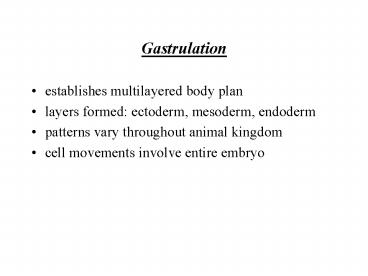Gastrulation - PowerPoint PPT Presentation
1 / 19
Title: Gastrulation
1
Gastrulation
- establishes multilayered body plan
- layers formed ectoderm, mesoderm, endoderm
- patterns vary throughout animal kingdom
- cell movements involve entire embryo
2
Types of cell movements
- epiboly movement of epith. sheets as a unit to
enclose deeper layers of embryo - invagination infolding of a region of cells
- involution inward movement of an outer layer
spreads over internal surface of external cells - ingression migration of indiv. cells from
surface to interior - delamination splitting of one cellular sheet
into 2 or more parallel sheets
3
Sea urchin gastrulationcell movements
- after hatching, veg. side thickens, flattens
- specialized cells (primary mesenchyme) appear in
veg. plate - extend filopodia dissociate from epith. sheet
and enter blastocoel - lineage pm cells are daughter cells of
micromeres - explore environment localize in ventrolateral
regions of blastocoel - form ventrolateral clusters and syncytial cables
- secrete calcium carbonate spicules (larval
skeleton)
4
Cues for migration of pm cells
- initial contacts of pm cells
- other cells in veg. plate
- hyalin layer
- basement membrane lining blastocoel
- change in affinity directs migration
- decreased affinity for neighbors, hyalin layer
- 100 fold increased affinity for basal lamina,
other ECM components of blastocoel
5
Cues for adhesion of pm cells
- exist in ventral region (evidence migration of
donor cells) - sensed by filopodia of pm cells
6
Archenteron invagination Stage I
- other cells in veg. plate fill in gaps as pm
cells leave gt flattening - veg. plate invaginates
- invag. archenteron (primitive gut endoderm)
- opening blastopore (anus)
7
Stage I Mechanisms
- caused by buckling of hyalin layer
- laminae in hyalin layer
- outer mostly hyalin
- inner mesh of fibropellin proteins
- veg. plate cells secrete chondroitin sulfate
proteoglycan (CSPG) into inner laminae - CSPG absorbs water gt swelling gt buckling
- veg. plate invaginates
- second force may come from movements of epith.
cells adjacent to veg. plate
8
Stages II III
- Stage II archenteron extends dramatically
- due to convergent extension (cells intercalate to
narrow tissue) - Stage II formation of secondary mesenchyme at
tip of archent. - filopodia attach to wall, pull up archent.
- mouth forms where archent. meets wall
9
Avian gastrulation
- differs from sea urchins and amphibians similar
to mammals - cleavage gave rise to blastodisc atop yolk
- 2 regions
- area pellucida (clear center above subgerm.
cavity) - area opaca (contact with yolk)
- most cells remain at surface (epiblast)
- hypoblast forms from polyinvagination islands and
posterior margin
10
Epiblast and hypoblast
- epi. and hypo. joined at area opaca space
blastocoel - epiblast gt embryo extraembryonic membranes
- hypoblast gt yolk sac, stalk to digestive tube
- next major event formation of primitive streak
11
Primitive Streak
- originates as thickening of epiblast near
posterior region - narrows and moves anteriorly
- cells converge depression forms (primitive
groove) - anterior end of streak gt Hensens node
- fate of cells migrating through streak / node
- node gt form foregut, head mesoderm, notochord
- streak gt endoderm, mesoderm
12
Formation of endoderm, mesoderm
- 1st cells to migrate form foregut (endoderm)
- cells move thru blastocoel displace hypoblast
(Fig. 6.28) - remaining hypoblast in anterior region forms
germinal crescent - next, epiblast cells ingress to form head
mesoderm, notochord (head process appears) - future meso., endo. ingress down length of embryo
- streak regresses
13
Endoderm, mesoderm contd.
- outcome
- epiblast is now ectoderm
- mesoderm fills blastocoel and notochord has
formed - endoderm has displaced hypoblast below area
pellucida - anterior-posterior gradient of maturity
established - ectoderm proliferates surrounds yolk by epiboly
(takes 4 days!)
14
Mechanisms Posterior endoderm, mesoderm
- select cells in epiblast express HNK-1 on cell
surface - HNK-1sulfated glucuronic acid
- migrate to posterior margin to form meso., endo.
- attracted to chemical in posterior margin
repelled by anterior marginal tissue - destroy HNK-1 cells with antibodies gt no
posterior endo. or meso.
15
Gastrulation in mammals
- gastrulation proceeds as though inner cell mass
were on top of imaginary yolk - modification trophoblast cells (supplemented by
mesoderm) - 1st step formation of hypoblast (primitive
endoderm or yolk sac endoderm) - result gt 2 layered embryo (epiblast, hypoblast)
- top layer of epiblast splits off to form amnion
(and amniotic cavity) - cavity fills with amniotic fluid - shock
absorber
16
Gastrulation in mammals
- cells on surface of embryonic epiblast (future
endoderm, mesoderm) begin to migrate thru
primitive streak - cells cease to express E-cadherin gt migrate
individually - those migrating thru Hensens node form notochord
- while rearrangement of inner cell mass takes
place, trophoblast cells begin to form placenta
17
Extraembryonic membranes
- yolk sac (hypoblast), amnion (epiblast),
allantois (outpocketing of yolk sac), chorion
(trophoblasts) - initial trophoblast cells cytotrophoblasts
- give rise to syncytiotrophoblast cells (nuclear
division without cytokinesis) - together, the 2 form the chorionic villi
- developmental pattern
- primary villi (cyto. encased in syncytio.)
- secondary villi (penetrated by mesoderm)
- tertiary villi (blood vessels, branching)
18
Placenta
- cytotrophoblasts adhere to uterine endometrium
(e.g. P-cadherin) - cytotrophoblasts also secrete proteases to break
assoc. between endometrial cells, remodel blood
vessels - villi are surrounded by lacunae (cavities filled
with blood) - maternal blood never mixes with blood of embryo
- villi chorion (embryonic / fetal portion of
placenta) - modified endometrium maternal portion of
placenta
19
The placenta as endocrine tissue
- besides facilitating exchange of gases
nutrients, placenta secretes pregnancy hormones - 3 major hormones produced
- human chorionic gonadotropin (hCG) gt stimulates
progesterone production in corpus luteum - progesterone (after 1st trimester primate
experiments) - chorionic somatomammotropin (placental lactogen)
gt maternal breast development































